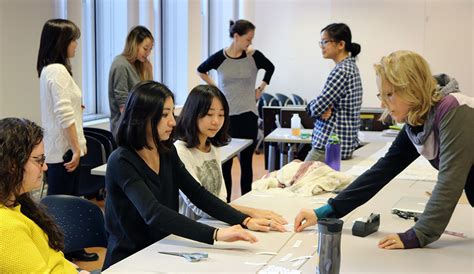As technology continues to advance at a rapid pace, the demand for professionals who can create intuitive and user-friendly digital experiences is greater than ever. Interaction design, a discipline that focuses on how users interact with digital products, has become a crucial component of the tech industry. In the United States, many universities offer comprehensive programs in interaction design to prepare students for successful careers in this field. In this blog post, we will delve into the world of interaction design programs in American universities, exploring the evolution of interaction design education, features of top programs, key courses in interaction design curricula, internship and job placement opportunities, renowned professors and industry experts, collaboration and industry partnerships, admission requirements and application processes, student experiences and alumni success stories, as well as the resources and support available for interaction design students. Whether you’re a prospective student, a current student, or simply curious about the field, this post will provide valuable insight into the exciting world of interaction design education in the U.S.
Table of Contents
Overview of Interaction Design Programs
Interaction design is a rapidly growing field that focuses on creating meaningful connections between people and the digital products and services they use. As technology continues to advance, the demand for professionals who can design intuitive and engaging user experiences has never been higher.
Top interaction design programs offer a comprehensive education in a wide range of disciplines, including psychology, human-computer interaction, graphic design, and more. These programs provide students with the skills and knowledge needed to design innovative solutions to complex problems, and to understand how people use technology in their daily lives.
Students in interaction design programs have the opportunity to work on real-world projects, collaborate with industry professionals, and gain hands-on experience in user research, prototyping, and usability testing. Graduates of these programs are well-equipped to pursue careers in a variety of industries, including technology, healthcare, entertainment, and more.
Overall, the field of interaction design continues to evolve, and the programs that prepare students for success in this field are constantly adapting to meet the needs of an ever-changing industry.
Evolution of Interaction Design in American Universities
Interaction design has come a long way in American universities, evolving from a niche area of study to a prominent discipline within the realm of design education. As technology continues to advance and integrate further into our daily lives, the importance of interaction design has become increasingly apparent, leading to its widespread adoption in academic institutions across the country.
With the rapid evolution of digital technology, American universities have recognized the need to adapt their design programs to include a focus on interaction design. This shift has been reflected in the expansion of course offerings, the establishment of specialized departments, and the hiring of industry professionals to provide students with the most relevant and up-to-date education in this field.
Furthermore, the evolution of interaction design in American universities has also been influenced by the demand for skilled professionals in the industry. As companies increasingly prioritize user experience in their product and service development, the need for qualified interaction designers has grown, prompting academic institutions to tailor their programs to meet this demand.
In conclusion, the evolution of interaction design in American universities has been driven by the recognition of its crucial role in shaping the future of technology and user experience. As the field continues to grow and develop, universities will undoubtedly continue to adapt and expand their interaction design programs to ensure that their students are equipped with the skills and knowledge necessary to succeed in this dynamic and influential industry.
Features of Top Interaction Design Programs
When it comes to choosing the right interaction design program, there are a few key features that define the top programs in the field. These programs are known for their comprehensive curriculum, experienced faculty, state-of-the-art facilities, and strong industry connections.
One of the most important features of a top interaction design program is its curriculum. These programs offer a wide range of courses that cover various aspects of interaction design, including user experience, user interface design, human-computer interaction, and design thinking. The curriculum is designed to provide students with a well-rounded education that prepares them for a successful career in the field.
In addition to the curriculum, the faculty at these top programs are often industry leaders and experts in the field of interaction design. They bring real-world experience and insights into the classroom, providing students with valuable guidance and mentorship. Furthermore, the facilities at these programs are equipped with the latest technology and resources, allowing students to work on projects and experiments that mimic real-world scenarios.
Lastly, these top programs have strong connections to industry partners, providing students with internship and job placement opportunities. These connections also allow students to work on real projects and research, giving them hands-on experience and networking opportunities that are essential for launching a successful career in interaction design.
Key Courses in Interaction Design Curricula
Interaction design is a rapidly growing field that requires a diverse set of skills and knowledge. To excel in this industry, it is essential to have a strong understanding of key courses in interaction design curricula. These courses are designed to provide students with the necessary skills and knowledge to succeed in the field of interaction design. Students will learn about various aspects of design, human-computer interaction, user research, prototyping, and much more.
One of the key courses in interaction design curricula is User Experience (UX) Design. This course focuses on understanding the needs and behavior of users and how to design products or services that meet those needs. Students will learn about usability testing, wireframing, and the importance of user-centered design.
Another essential course is Interaction Design Principles. This course covers the fundamental principles of interaction design, such as affordances, signifiers, and feedback. Students will learn how to create intuitive and seamless interactions between users and products or services.
Moreover, Visual Design is a crucial course in interaction design curricula. This course teaches students about the importance of visual aesthetics and how to use design elements such as color, typography, and layout to create visually appealing and effective user interfaces.
Internship and Job Placement Opportunities
One of the most important factors to consider when choosing an Interaction Design program is the internship and job placement opportunities available to students. Internship experiences can provide valuable hands-on experience, networking opportunities, and potentially lead to full-time employment after graduation. Many programs have strong relationships with industry partners and offer resources to help students secure internships at top companies in the field.
Job placement opportunities are also a key consideration for students looking to enter the workforce after completing their degree. High-quality programs often have a track record of alumni success stories, with graduates going on to work at top companies and design firms. These programs may also offer career resources and support, such as resume workshops, interview preparation, and job fairs to help students land their dream job.
It’s important to research the placement rate for graduates of a particular program, as well as the types of companies that frequently hire graduates. Programs with strong ties to the industry may have a higher placement rate and access to a wider range of job opportunities.
Overall, internship and job placement opportunities are crucial factors to consider when choosing an Interaction Design program, as they can greatly impact the success and career prospects of students after graduation.
Distinguished Professors and Industry Experts
When looking for an interaction design program, it’s essential to consider the faculty and industry experts who will be guiding and mentoring you throughout your education. Distinguished professors and industry experts bring real-world experience and valuable insights to the classroom, enhancing the learning experience for students.
Top interaction design programs often have faculty members who are not only experts in their field but also actively engaged in industry work. This means that students have the opportunity to learn from individuals who are at the forefront of interaction design trends and are able to share relevant, up-to-date knowledge with their students.
Furthermore, having industry experts as part of the faculty can also open doors for students in terms of networking and career opportunities. Students may have the chance to connect with these experts, gain valuable insights, and even secure internships or job placements through these connections.
Overall, the presence of distinguished professors and industry experts in an interaction design program is a significant advantage for students, as it ensures that they are learning from the best in the field and are well-equipped to succeed in the industry upon graduation.
Collaboration and Industry Partnerships
When it comes to pursuing a career in interaction design, collaboration and industry partnerships play a crucial role in shaping the educational experience and preparing students for the real world. Many top interaction design programs have established strong connections with industry leaders, which benefits students in various ways.
Firstly, these partnerships provide students with valuable opportunities to work on real-world projects with industry professionals. This hands-on experience allows students to apply their skills in a professional setting and gain insight into the challenges and demands of the industry.
Additionally, collaboration with industry partners can also lead to internship and job placement opportunities for students. Through these partnerships, students have the chance to network with potential employers and gain access to exclusive job openings and internships.
Furthermore, these partnerships often result in guest lectures, workshops, and mentorship programs conducted by industry experts. This direct interaction with professionals provides students with valuable insights and guidance as they navigate their academic and professional journey in the field of interaction design.
Admission Requirements and Application Process
When applying for a top Interaction Design program, it’s important to be aware of the admission requirements and application process. The first step is to carefully review the specific requirements for each program you are interested in. Most programs require a bachelor’s degree from an accredited institution, with a strong emphasis on design or related fields. Some programs may also require a portfolio of previous design work to be submitted as part of the application process.
Additionally, prospective students may need to provide letters of recommendation, a statement of purpose, and transcripts from previous educational institutions. These materials provide admissions committees with a comprehensive understanding of an applicant’s academic and professional background. It’s crucial to carefully follow all application instructions and deadlines to ensure that your materials are received and reviewed in a timely manner.
In some cases, programs may also require applicants to complete an admissions interview or provide additional documentation to support their application. It’s essential to thoroughly research and understand the specific requirements for each program to which you are applying in order to present a strong and competitive application package.
Overall, the admission requirements and application process for Interaction Design programs are designed to assess an applicant’s potential for success in the program and their ability to contribute to the field of design. By carefully preparing and submitting a comprehensive application, prospective students can increase their chances of being admitted to a top program and begin their journey toward a successful career in Interaction Design.
Student Experiences and Alumni Success Stories
As interaction design continues to gain popularity, more and more students are pursuing degrees in this field. The journey of an interaction design student is often filled with challenges, but it is also incredibly rewarding. Hearing success stories from alumni can be a source of inspiration for current students.
Many interaction design programs offer opportunities for students to connect with alumni. These connections can provide invaluable insights into the industry and help students navigate their own career paths. By hearing about the experiences of those who have gone before them, students can gain a better understanding of what to expect after graduation.
Alumni success stories also serve as a testament to the quality of the interaction design programs offered by various universities. When alumni go on to secure notable positions in the industry or launch successful design ventures, it reflects positively on the program they graduated from. This, in turn, can attract more prospective students who are seeking a reputable and impactful program.
Overall, student experiences and alumni success stories play a crucial role in shaping the reputation and effectiveness of interaction design programs. By showcasing the achievements of past students, these programs can inspire current students and demonstrate the potential for a rewarding career in the field of interaction design.
Resources and Support for Interaction Design Students
Interaction design is a rapidly growing field that requires students to be equipped with the necessary resources and support to succeed in their academic and professional endeavors. With the increasing demand for interaction design professionals, it is essential for universities to provide students with access to a wide range of resources and support systems.
One of the key resources for interaction design students is access to cutting-edge technology and software. Many universities have state-of-the-art labs and workshops equipped with the latest tools and software used in the industry. This allows students to gain hands-on experience and stay at the forefront of technological advancements in the field.
Another crucial aspect of support for interaction design students is access to experienced faculty members and industry experts. Universities often have distinguished professors and industry professionals who provide mentorship and guidance to students. Their expertise and insights play a crucial role in shaping the students’ understanding of the field and preparing them for the real-world challenges they will face in their careers.
Furthermore, universities also offer a range of support services such as career counseling, networking events, and internship opportunities. These resources help students connect with potential employers, gain practical experience, and build a strong professional network within the industry. Additionally, academic support services such as tutoring, peer mentorship programs, and study groups further contribute to the success of interaction design students.





